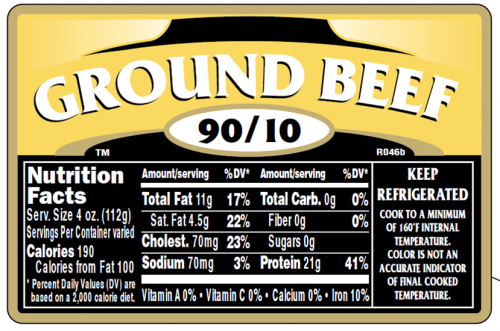“Singing Kumbaya,” GMA/FMI displays preemptive label design
I listened in on the conference call at which the Grocery Manufacturers of America and the Food Marketing Institute announced their new Nutrition Keys design for front-of-package labels.
My favorite comment: We are all “singing kumbaya” here. Nutrition Keys, they said, was the result of a” monumental, historic effort” in which food companies “stepped up to the plate in a big way,” “with 100% support.”
Why did they go to all this trouble? Because “A healthy consumer makes for a happy consumer.”
Kumbaya, indeed.
The real reason, as I explained yesterday, is to preempt the FDA’s front-of-package food labeling initiatives which might make food companies reveal more about the “negatives” in processed foods.
Here’s what GMA and FMI say the new label will look like:
Four of these things are required: Calories, Saturated fat, Sodium, and Total (not added) sugars. Packages can also display up to two “nutrients to encourage” picked from this collection: protein; fiber; vitamins A, C, and D; and potassium, iron, and calcium.
Let’s give these food trade associations credit for listing sugars instead of the Institute of Medicine’s recommendation for trans fat. Trans fats are already gone from most processed foods. Everyone cares about sugars. But these are total sugars, not added sugars, which is what really matters.
And protein? Since when does protein need to be encouraged in American diets? We already eat twice the protein we need. The rationale? Vegetarians. I repeat. Since when don’t vegetarians get enough protein? Never mind, protein makes the products look better.
Nutrition Keys merely repeats what’s on the Nutrition Facts labels, only worse. It makes the percent Daily Values practically invisible. Which is better? High or low milligrams or grams. You have to know this, and Nutrition Keys doesn’t help with that problem.
Nutrition Keys, says the industry, is about “more clarity in labeling.” Really? Here’s what it will look like on a food package.
I’ve been collecting reactions.
Although GMA and FMI insist they they are doing this in response to the First Lady’s Let’s Move campaign, the White House issued this statement:
The White House, including the First Lady, recognizes these companies for the leadership they have shown in advancing this initiative. We regard their commitment to dedicate space, for the first time, to an industry-wide front-of-pack label as a significant first step and look forward to future improvement. The FDA plans to monitor this initiative closely and will work with experts in the field to evaluate whether the new label is meeting the needs of American consumers and pursue improvements as needed. We will continue to work on seeking solutions for the problem of childhood obesity in America.
Congresswoman Rosa DeLauro was more forthcoming:
The industry’s unveiling today of its front-of-package labeling system is troubling and confirms that this effort should not circumvent or influence FDA’s effort to develop strong guidelines for FOP labels.
Given that negative and positive nutrients will not be differentiated on the package, there is significant risk that these labels will be ignored. An adequate labeling system must clearly alert consumers about potentially unhealthy foods, and should not mislead them into believing that some foods are healthy when they clearly are not.
Reporters asked tough questions on the conference call about preemption of FDA efforts to do front-of-package labeling in a rational way (see my post from yesterday). Perhaps space limitations made full accounts impossible:
- USA Today story (I’m quoted)
- Washington Post
- New York Times






